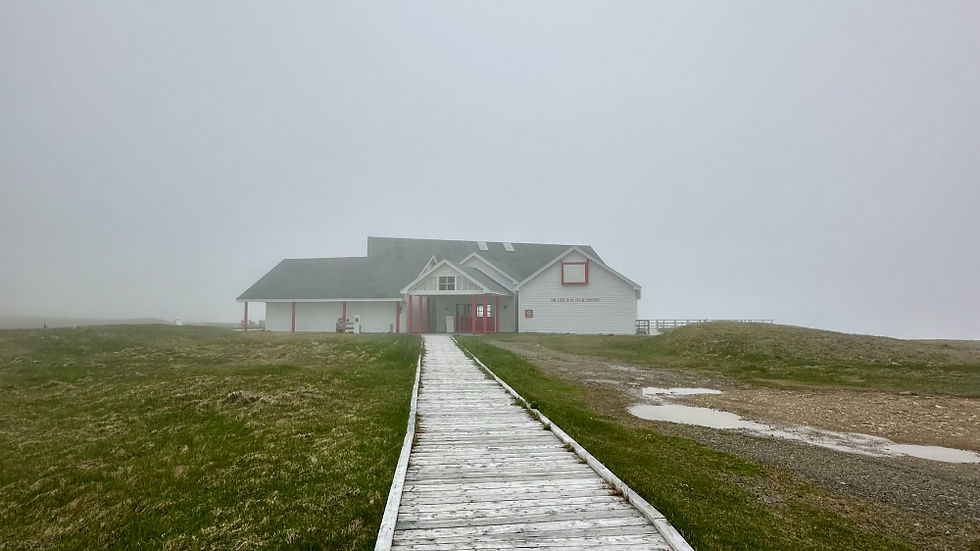Birding Cape St. Mary's
- truenorthbirding

- Aug 14
- 5 min read
Updated: Sep 10
After a couple of epic days at the Puffin Viewing Site, my next stop was the southwestern tip of the Avalon Peninsula, Cape St. Mary's Ecological Reserve. Instead of driving straight from Bonavista, I decided to break up the four-hour drive with a night in one of my favorite places in Newfoundland, Dildo.

Discovering Dildo
I visited Dildo for the first time in 2022. It was a day trip from St. John's. While the ridiculous name initially drew me in, the hospitality of the locals made me return. The name itself has no clear origin, but it has been around since the 1700s. So, it wasn't just invented to attract curious tourists like me.
Dildo was brought to 'fame' by Jimmy Kimmel. He became obsessed with the town and ran to become the mayor in 2019. Kimmel won the election in a landslide and remains the honorary Mayor of Dildo. I don't think he ever made it to Newfoundland, but he did donate the Hollywood-like Dildo sign for the town. All jokes aside, Dildo is adorable and worth a visit on its own merit. I recommend grabbing a meal and a beer flight at the Dildo Brewing Company. You should also pick up some Dildo goodies at Nan & Pop's Dildo Souvenir Shop.

The Journey to Cape St. Mary's
After leaving Dildo, it was about a two-hour drive to Cape St. Mary's. I took Route 100 (the Cape Shore Trail), where I almost ran into a bear and her cub right on the road. Being from Alberta, I didn't think much about the encounter. Later, I learned that black bears are not super common on the Avalon Peninsula, so I felt very lucky to have spotted them.
I had clear skies the whole drive until about 15 minutes from the entrance. Locals say that if it is foggy in St. John's, it will be clear in Cape St. Mary's, and vice versa. However, I wouldn't bother planning your trip based on the weather. Just go!

Exploring Cape St. Mary's Ecological Reserve
Cape St. Mary's Ecological Reserve is one of the most accessible places to see nesting seabirds up close. According to the government of NL, during the breeding season, Cape St. Mary's is home to tens of thousands of Northern Gannets, Black-legged Kittiwakes, and Common & Thick-billed Murres. In addition, hundreds of Razorbills, Black Guillemots, Double-crested & Great Cormorants, and Northern Fulmars nest there. The most amazing part is that you can see all these birds from land, which is extra amazing if you are prone to sea-sickness, like me.

It is about a kilometer walk from the interpretation center to the viewing point. While access to the interpretation center is accessible, the walk to the viewing point is not. The path is not super treacherous, but it was extremely muddy and slippery during my visit. The usual weather for Cape St. Mary's is 'RDF' (rain, drizzle, fog), so I think the walking path is probably always muddy. Due to the thick fog, I think I missed some gorgeous views on the walk, but instead, I got the super creepy version! There were only a few other cars parked when I arrived, so I walked to the viewing point entirely alone. Honestly, it was kind of spooky in the thick fog. I had no idea how far or close I was to the birds until I smelled them!

I noticed the smell way before seeing the handful of folks ahead of me. I don't know why this surprised me, as I knew there were tens of thousands of nesting birds here.
There was a cacophony of smells and bird calls as I walked closer to the viewing point. As you can see in my video, it was still super foggy, so I am unsure how scary it would have been to see how high up I was (about 130 meters above sea level).

While the fog did limit how far I could see and obscured many nesting birds in the cliffs, I did see thousands of birds. Across from the viewing point, Bird Rock was covered in nesting Northern Gannets. I watched many birds tending to their eggs. Gannets build small mounds for their nests, often made out of grass, seaweed, sticks, and mud. The female lays a single egg, which is incubated by both the male and the female.

From my understanding, Northern Gannets sometimes mate for life. Males return to the same nest every year, building upon it year after year. One of the most iconic things Gannets do is 'billing,' when a pair touch or clack their beaks together. This is thought to be a courtship display that reinforces the pair's bond.

One of my other favorite birds that landed very close to the viewing site was the Razorbill. The Razorbill nests were further away in the foggy cliffs, but a few decided to pose close to the viewing site. Razorbills are in the same family as Puffins, which is probably why I find them super cute as well. These little guys can blend right in with Common Murres, and they can often be found nesting together. I love that the inside of their mouths is bright yellow. My photo isn't great, but you can kind of get the idea.

The other birds that are relatively easy to see at Cape St. Mary's are Common Murres. You can find Common Murres on both coasts of Canada, but you can only see the ones wearing white eyeliner (aka bridled) on the East Coast. I assume there were Thick-billed Murres at Cape St. Mary's, but I didn't spot any until I did a boat tour of Witless Bay later in my vacation.

I could make out nesting Black-legged Kittiwakes through the fog, but none were close enough to get clear pictures. I am sure there were many other birds I couldn't see shrouded in fog. My advice, which I will follow for my next trip, would be to spend a night close to Cape St. Mary's. This way, you can visit at least twice, hopefully getting at least one day with fog-free views.
Lunch at Da Bird's Eye Restaurant
After spending the morning with the Gannets, I was ready for lunch. There aren't many restaurants close to Cape St. Mary's, so it's important to pre-plan what will be open or to bring a picnic. I decided to drive about 20 minutes to St. Bride's, to Da Bird's Eye Restaurant. It was surprisingly busy when I went, but the service was quick. Da Bird's Eye is a classic Newfoundland diner, with standards like fish and chips and hot turkey sandwiches. The food was reasonably priced and delicious; I highly recommend it.

Conclusion: A Memorable Experience
In summary, I had a great time at Cape St. Mary's, and my only regret is not spending another day there. Don't be discouraged if it is foggy; you will still be rewarded with thousands of seabirds. At around two and a half hours from St. John's, you can make it in a day trip, but it would be more fun to overnight somewhere on the way. Let me know if you had a visit without fog!








Comments